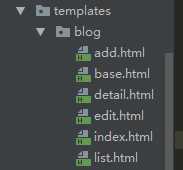标签:body template NPU files doc href extends 模型 res
本项目基于学习阶段,只是涉及简单的crud与模板变量等操作.
1.创建blog app项目:
python manage.py startapp blog,并在项目主目录的settings.py中注册该app
INSTALLED_APPS = [ ‘django.contrib.admin‘, ‘django.contrib.auth‘, ‘django.contrib.contenttypes‘, ‘django.contrib.sessions‘, ‘django.contrib.messages‘, ‘django.contrib.staticfiles‘, ‘book‘, ‘common‘, ‘info‘, ‘blog‘, ]
2.创建好app后,首先创建数据库模型models.py:
from django.db import models # Create your models here. class Blog(models.Model): id = models.AutoField(primary_key=True) title = models.CharField(max_length=30) content = models.TextField(max_length=300)
并通过manage.py管理工具生成迁移文件,并映谢到数据库中.
3.在blog APP中创建templates模板文件目录并在里面创建blog目录

主要页面有:主页,列表页,添加页,编辑页,详情页与模板基类页
base.html:
<!DOCTYPE html> <html lang="en"> <head> <meta charset="UTF-8"> <title> {% block title %} 标题 {% endblock %}</title> </head> <body> {% block body %} 内容 {% endblock %} </body> </html>
add.html:
{% extends ‘blog/base.html‘ %} {% block title %} 添加文章 {% endblock %} {% block body %} <h1>添加文章</h1><br> <form action="" method="post"> {% csrf_token %} 标题:<input type="text" name="title"><br> 内容:<textarea placeholder="请输入内容" name="content" cols="30" rows="10"></textarea><br> <button type="submit">发布文章</button> </form> {% endblock %}
index.html:
{% extends ‘blog/base.html‘ %} {% block title %} 首页 {% endblock %} {% block body %} <tr> <td><a href={% url ‘blog_add‘ %}>添加文章</a></td> <td><a href={% url ‘blog_list‘ %}>文章列表</a></td> </tr> {% endblock %}
list.html:
{% extends ‘blog/base.html‘ %}
{% block title %}
文章列表
{% endblock %}
{% block body %}
<h1>文章列表</h1>
<table width="400px">
<thead>
<tr>
<th>标题</th>
<th>操作</th>
</tr>
</thead>
<tbody>
{% for blog in blogs %}
<tr>
<th><a href={% url ‘blog_detail‘ blog.id %}>{{ blog.title }}</a></th>
<th><a href={% url ‘blog_modify‘ blog.id %}>编辑</a>|<a href={% url ‘blog_delete‘ blog.id %}>删除</a></th>
</tr>
{% endfor %}
</tbody>
</table>
{% endblock %}
edit.html:
{% extends ‘blog/base.html‘ %} {% block title %} 修改文章 {% endblock %} {% block body %} <h1>修改文章</h1><br> <form action="" method="post"> {% csrf_token %} 标题:<input type="text" name="title" value={{ blog.title }}><br> 内容:<textarea placeholder="请输入内容" name="content" cols="30" rows="10">{{ blog.content }}</textarea><br> <button type="submit">修改</button> </form> {% endblock %}
detail.html:
{% extends ‘blog/base.html‘ %} {% block title %} {{ blog.title }} {% endblock %} {% block body %} <h1>文章详情</h1> {{ blog.content }} {% endblock %}
4.创建好模板文件后,创建相对应的urls.py:
from django.conf.urls import url from . import views urlpatterns = [ url(r‘^$‘, views.index,name=‘blog_index‘), url(r‘^add/$‘, views.add,name=‘blog_add‘), url(r‘^list/$‘, views.list,name=‘blog_list‘), url(r‘^detail/(?P<blog_id>\d+)$‘, views.detail,name=‘blog_detail‘), url(r‘^delete/(?P<blog_id>\d+)$‘, views.delete,name=‘blog_delete‘), url(r‘^modify/(?P<blog_id>\d+)$‘, views.modify,name=‘blog_modify‘), ]
5.创建相对应的视图文件views.py:
from django.shortcuts import render,HttpResponse,reverse,redirect
from .models import Blog
# Create your views here.
def index(request):
return render(request,‘blog/index.html‘)
def add(request):
if request.method == ‘GET‘:
return render(request,‘blog/add.html‘)
elif request.method == ‘POST‘:
#获取表单内容
title = request.POST.get(‘title‘)
content = request.POST.get(‘content‘)
#添加到数据库中
Blog.objects.create(title=title,content=content)
return HttpResponse(‘发布成功‘)
else:
return HttpResponse(‘这是不能处理的操作‘)
def list(request):
blogs = Blog.objects.all()
return render(request,‘blog/list.html‘,{‘blogs‘:blogs})
def detail(request,blog_id=0):
blog = Blog.objects.get(id=blog_id)
return render(request,‘blog/detail.html‘,{‘blog‘:blog})
def delete(request,blog_id=0):
blog = Blog.objects.get(id=blog_id)
if blog:
blog.delete()
return redirect(reverse(‘blog_list‘))
else:
return HttpResponse(‘要删除的数据不存在‘)
def modify(request,blog_id=0):
blog = Blog.objects.get(id=blog_id)
if blog:
if request.method == ‘GET‘:
return render(request, ‘blog/edit.html‘, context={‘blog‘: blog})
elif request.method == ‘POST‘:
title = request.POST.get(‘title‘)
content = request.POST.get(‘content‘)
blog.title = title
blog.content = content
blog.save()
return HttpResponse(‘修改成功‘)
else:
return HttpResponse(‘该操作无法执行‘)
else:
return HttpResponse(‘数据不存在‘)
标签:body template NPU files doc href extends 模型 res
原文地址:https://www.cnblogs.com/remoting-py/p/9134837.html